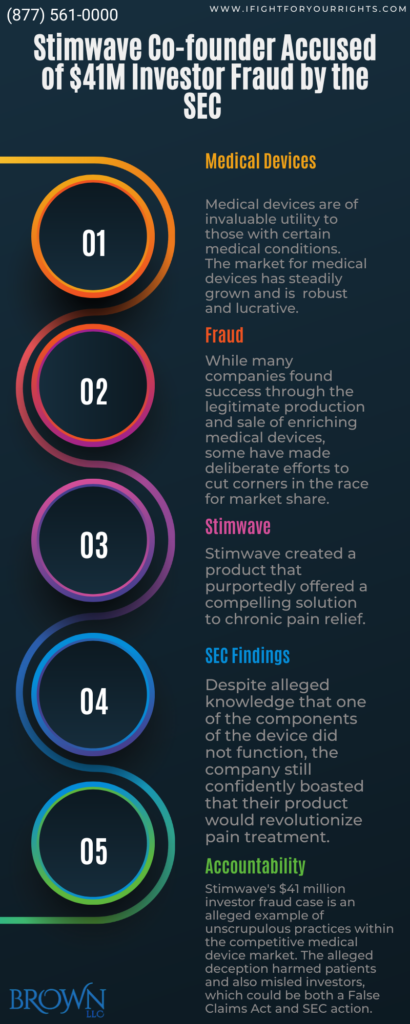Stimwave Co-founder Accused of $41M Investor Fraud by the SEC

A Newly Emerged Medical Device Market
Medical devices and equipment are of invaluable utility to those with certain medical conditions. In many cases, these devices offer lifesaving or life-changing treatment. As such, the market for medical devices has steadily grown and is now both robust and lucrative. Indeed, many publicly traded companies like Abbott, Medtronic, and Johnson and Johnson have seen enormous profit contributions stemming from the sale and use of their produced medical equipment. Medtronic, for example, saw $31.23 billion in revenue from medical devices in 2023.[1] Dexcom (DXCM), a medical device company that specializes in glucose monitoring, saw nearly a 20.34% increase in its stock over the last year.[2] Dexcom is now worth nearly $50 billion. Medtronic, for its part, is worth $115 billion[3], making it one of the largest medical device specialist companies in the world.
While many, if not most, of these companies found success through the legitimate production and sale of enriching medical devices, some companies and individuals have made deliberate efforts to cut corners and have even committed outright fraud in the race for market share. Stimwave, a small medical device startup, is accused of this very practice. The company, in its attempts to remain competitive and profitable in a now saturated market, allegedly engaged in criminal fraud when the company sold a fake medical device component and implanted it into patients. In doing so, the company may have harmed both patients and investors and may have both committed investor fraud as the SEC announced that they were charging the company with $41 million in fraud and potentially a False Claims Act violation if the federal government paid for the part and it’s found to be knowingly faulty.
What was Stimwave purportedly selling? And what did patients actually receive?
Stimwave created a product that purportedly offered a compelling solution alternative to chronic pain relief. Given the danger of powerful painkillers and the trend to cut down on opiate prescriptions, there is a strong market for any who can credibly offer non-medicated pain relief. For these reasons, patients with chronic pain and investors were equally intrigued by the company’s statements of its device’s effectiveness. Per the SEC, “The device consisted of three key components: (1) a transmitter; (2) a receiver; and (3) an electrode array. The transmitter was worn by patients in a pouch outside the body and sent a wireless signal into the body. A receiver and electrode array were implanted inside patients’ bodies and were together supposed to receive the signal and convert it into electrical currents that stimulated target nerves. As alleged, Stimwave included two receivers of different sizes with the PNS Device, the smaller of which was designed to be used when the larger receiver was too big to implant.
The SEC’s complaint alleges that Perryman knew, or was reckless in not knowing, that the smaller receiver was, in reality, fake and nothing more than a piece of plastic.”[4] The company’s conduct was allegedly particularly outrageous, given the fact that they not only knowingly sold an inoperable medical device, but went so far as to implant that device into unsuspecting patients. The company, in bare terms, found patients in chronic pain, promised them innovative and drug free relief, implanted a non-functioning piece of plastic into their bodies, and charged them for the entire process while allegedly defrauding the investors.
Speak with the Lawyers at Brown, LLC Today!
Over 100 million in judgments and settlements trials in state and federal courts. We fight for maximum damage and results.
Charges against Stimwave
Per the SEC’s filing, Stimwave is being charged with making false and misleading statements about the company’s key medical device. The SEC alleges that the company was aware that one of the components of the device, which was implanted into patients, did not function. Despite knowledge of this fact, the company still confidently boasted that their product was one of a kind, and that it would revolutionize pain treatment. They also readily leapt at opportunities to sell and implant their product, despite its purported lack of functionality, and despite the potential risk for patient harm.
The SEC also alleges that the company intentionally “misrepresented to investors that the PNS Device was approved by the U.S. Food and Drug Administration and was the only effective device of its kind on the market. The complaint also alleges that [the company] made false and misleading statements to investors about Stimwave’s historical revenues, revenue projections, and business model. After [the company’s] fraud unraveled in the fall of 2019, Stimwave voluntarily recalled the PNS Devices and eventually filed for bankruptcy.” [5] The SEC seeks disgorgement plus prejudgment interest, a civil penalty, an officer bar, a director bar, and permanent injunctions. The former CEO is also facing criminal securities fraud charges, filed in a parallel action by the US Attorney’s Office in the Southern District of New York. [6]
SEC Fraud and the Office of the Whistleblower
The fraudulent conduct committed by Stimwave is representative of the length criminals will go to gain advantages in newly emerging, competitive markets. Given this reality, the SEC and DOJ have made it a priority to investigate, uncover, and punish fraud to the full extent allowed under the law. However, federal law enforcement officials cannot uncover this fraud without help. It is largely well-informed whistleblowers who initially bring these cases of fraud to the attention of the SEC and DOJ. In so doing, these SEC whistleblowers act to prevent, or address fraud, and stand to personally benefit from their reporting at the same time.
The procedure usually first involves a tip from an SEC whistleblower. SEC investigations follow suit based on these tips. And because tips are so valuable, the SEC has made efforts to incentive their steady submission. Indeed, SEC whistleblowers may receive up to 30% if their information proves helpful and timely to an SEC investigation. In fact, because the SEC recognized the importance and success of cases involving whistleblowers, the SEC created the dedicated SEC Office of the Whistleblower, which has already collected over 6 billion in recovery in its short 12-year history. Two billion dollars in financial remedies were awarded in SEC whistleblower payouts. [7] In 2023 alone, the SEC provided 68 individuals a total of $600 million in SEC whistleblower awards—with those figures projected to significantly increase in 2024. With the use of an SEC whistleblower attorney the individual has the chance to remain anonymous from start to finish if they file the TCR with the SEC appropriately.
Stimwave’s $41 million investor fraud case exposes allegedly unscrupulous practices within the competitive medical device market. The alleged deliberate deception not only harmed patients but also misled investors with false claims. An insider serving as a whistleblower many not only be eligible to up to 30% of what the government recovers which could be an SEC whistleblower reward in the tens of millions, but also can go to sleep knowing they did the right thing and that their timely disclosure could potentially save lives.
[1] https://www.proclinical.com/blogs/2023-10/top-10-medical-device-companies-in-the-world-in-2023
[2] https://www.google.com/finance/quote/DXCM:NASDAQ
[3]https://www.google.com/finance/quote/MDT:NYSE?sa=X&ved=2ahUKEwiUme2thNiDAxVIrYkEHdWhDEUQ3ecFegQIchAX
[4] https://www.sec.gov/news/press-release/2023-255
[5] https://www.sec.gov/news/press-release/2023-255
[6] https://www.sec.gov/news/press-release/2023-255
[7] Securities and exchange commission office of the whistleblower annual report to congress for fiscal year 2023. (2023). SEC Office of the Whistleblower. https://www.sec.gov/files/2023_ow_ar.pdf

